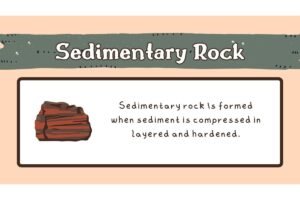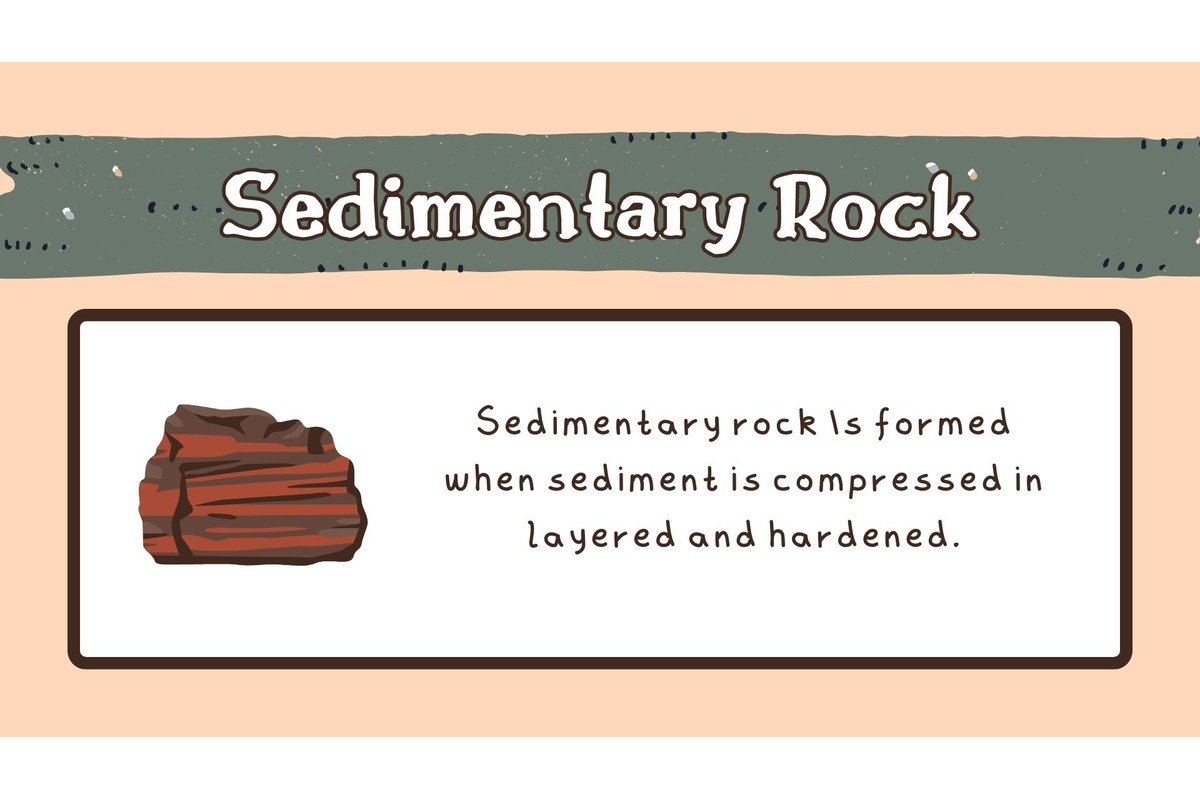Introduction to Sedimentary Rocks
Sedimentary rocks are one of the three major types of rocks, alongside igneous and metamorphic rocks. Unlike igneous rocks, which form from molten magma, and metamorphic rocks, which result from the alteration of existing rocks under heat and pressure, sedimentary rocks are primarily formed through the deposition and cementation of mineral and organic particles.
Definition of Sedimentary Rocks

Sedimentary rocks are composed of sediments, which may include minerals, organic matter, and fragments of other rocks, that have been deposited by various agents such as water, wind, ice, or gravity.
Importance in Geology
These rocks hold crucial information about Earth’s history, including past climates, landscapes, and ecosystems. They also serve as valuable resources for understanding fossil fuels, groundwater reservoirs, and even archaeological sites.
Classification of Sedimentary Rocks
Sedimentary rocks are classified into Clastic sedimentary rocks, Non-clastic sedimentary rocks, inorganic and organic rocks based on their origin and composition: detrital different types of sedimentary rocks are as fellows;
Clastic Sedimentary Rocks: Arenaceous and Argillaceous Varieties
Clastic sedimentary rocks, also known as detrital rocks, are composed of mineral and rock fragments, or clasts, derived from the weathering and erosion of pre-existing rocks. Arenaceous rocks, such as sandstone, are predominantly made up of sand-sized particles, while argillaceous rocks, like shale, consist mainly of clay-sized particles. The distinction between these two types lies in the dominant particle size and mineral composition.
Arenaceous Rocks (Sandstone)
Sandstone is a common type of clastic sedimentary rock characterized by its sandy texture and often visible grains of sand. It forms from the accumulation and cementation of sand-sized particles, typically composed of quartz or feldspar minerals. Sandstone deposits can vary in color, texture, and composition, reflecting the different geological processes and environments in which they formed.
Argillaceous Rocks (Shale)
Shale is another prevalent clastic sedimentary rock, characterized by its fine-grained texture and high clay content. It forms from the compaction and cementation of clay, silt, and other fine-grained particles. Shale is typically thinly laminated and often exhibits fissility, the tendency to split into thin layers along bedding planes. It is commonly found in sedimentary basins and is an essential component of the Earth’s crust.
Non-Clastic Sedimentary Rocks: Calcium Carbonate Rocks
Non-clastic sedimentary rocks, also known as chemical or organic rocks, form through chemical processes or the accumulation of organic materials. One of the most abundant types of non-clastic sedimentary rocks is those composed of calcium carbonate, including limestone.
Calcium Carbonate Rocks (Limestone)
Limestone is a versatile and widespread sedimentary rock composed primarily of calcium carbonate (CaCO3) minerals, such as calcite or aragonite. It forms in marine environments through the precipitation of calcium carbonate from seawater, often facilitated by biological processes involving marine organisms like corals, shellfish, and algae. Limestone can vary in color and texture, ranging from dense and crystalline to porous and fossiliferous.
Inorganic vs. Organic Sedimentary Rocks: Calcareous and Carbonaceous Varieties
Sedimentary rocks can be further categorized into inorganic and organic varieties based on their origin and composition. Inorganic sedimentary rocks, like limestone, form through chemical processes or the accumulation of inorganic materials. Organic sedimentary rocks, such as coal, result from the accumulation and compression of organic matter derived from living organisms.
Calcareous Rocks (Limestone)
Calcareous rocks, like limestone, are predominantly composed of calcium carbonate minerals and form through chemical precipitation or the accumulation of calcareous remains of marine organisms. Limestone deposits are abundant worldwide and have significant economic importance as building materials, raw materials for cement production, and sources of lime for agriculture and industry.
Carbonaceous Rocks (Coal)
Carbonaceous rocks, such as coal, are organic sedimentary rocks formed from the accumulation and transformation of plant debris in swampy environments over millions of years. Coal is primarily composed of carbon-rich organic matter, with varying degrees of maturity and organic content. It is a vital energy resource, used for electricity generation, industrial processes, and heating.
Key Characteristics of Sedimentary Rocks
Sedimentary rocks exhibit several characteristic features that distinguish them from other rock types.
Stratification
Sedimentary rocks often display distinct layers, or strata, which reflect changes in sedimentation over time. These layers may contain different sediment types, grain sizes, or fossil assemblages, providing valuable information about past environments.
Fossils
Sedimentary rocks frequently contain fossils, preserved remains or traces of ancient organisms. Fossils offer insights into past ecosystems, climate conditions, and evolutionary history.
Grain Size and Sorting
The grain size and sorting of sedimentary rocks can provide clues about the energy and distance of transport during deposition. Well-sorted rocks indicate uniform transport conditions, while poorly sorted rocks suggest varying energy levels.
Significance of Sedimentary Rocks
Sedimentary rocks play significant roles in both scientific research and practical applications.
Environmental Indicators
By studying sedimentary rocks, geologists can reconstruct past environments and climates, helping to understand natural processes and predict future changes.
Economic Importance
Sedimentary rocks are valuable sources of various resources, including fossil fuels like coal and oil, construction materials like sand and gravel, and industrial minerals like limestone and gypsum.
Conclusion
Sedimentary rocks represent a diverse and important component of the Earth’s crust, offering valuable insights into geological history, environmental conditions, and economic resources. By understanding the different types and characteristics of sedimentary rocks, scientists can unravel Earth’s past and better prepare for its future.
Unique FAQs
- What are the main differences between sedimentary, igneous, and metamorphic rocks? Sedimentary rocks form from the accumulation and cementation of sediments, igneous rocks crystallize from molten magma, and metamorphic rocks result from the alteration of existing rocks under heat and pressure.
- How do scientists determine the age of sedimentary rocks? Scientists use various dating techniques, including relative dating based on the principle of superposition and absolute dating methods like radiometric dating.
- Can sedimentary rocks contain valuable minerals? Yes, sedimentary rocks can contain economically significant minerals, such as coal, oil, natural gas, and various ores.
- Why are fossils commonly found in sedimentary rocks? Fossils are often preserved in sedimentary rocks because the processes of burial and lithification protect organic remains from decay and degradation.
- What role do sedimentary rocks play in understanding past climates? Sedimentary rocks preserve evidence of past climates through indicators such as sediment layers, fossil assemblages, and chemical compositions, providing valuable data for climate reconstructions.






One thought on “Sedimentary Rocks”